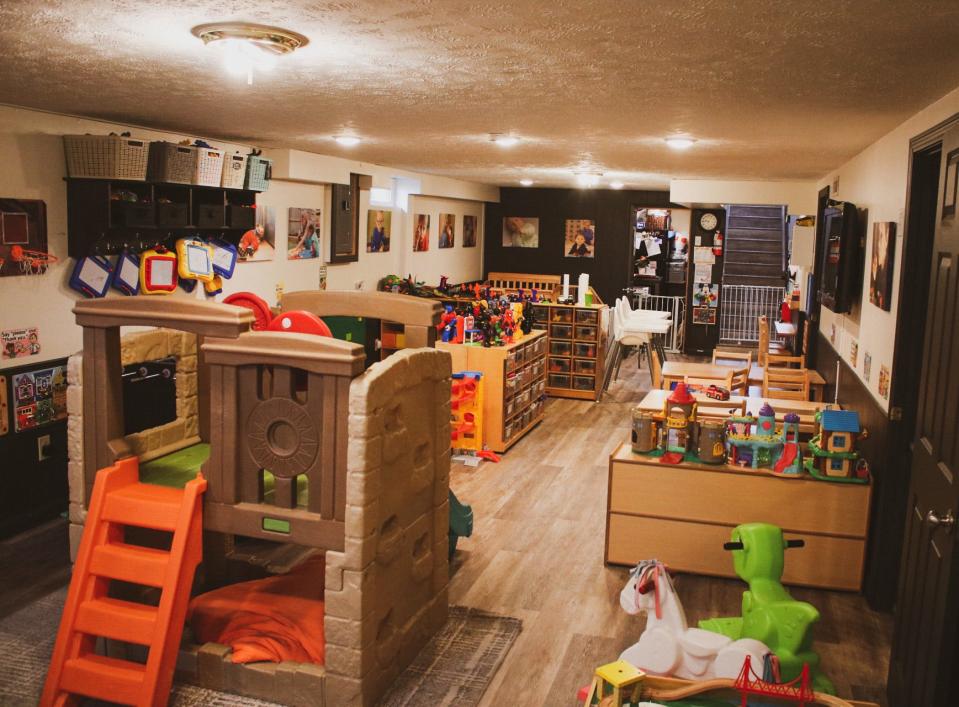A new fund aims to increase child care availability in the Salina community. Here's how
After years of declining child care availability and stagnant wages in the profession, a new initiative is looking to make strong and lasting steps toward improving child care shortages in Saline County.
In the county, like much of the nation, child care availability is diminishing for families. As of July 2023, there are an estimated 1,000 to 1,500 fewer available child care spaces than needed, according to Child Care Aware of Kansas, a statewide resource and referral agency.
This means for every opening at a local facility, there are 10 children in need of that spot.

It's an issue that is both widespread, affecting communities across the U.S., and deeply personal for families in Salina who are searching for quality care close to home.
"Wages have been pinpointed as the No. 1 critical piece as to why we’re struggling to retain child care workers and keep rooms open at centers,” said Claire Ludes, executive director of the Salina Area United Way.
Early Childcare Initiative Fund will work to address wages, capacity at existing facilities
The lack of child care availability is a multifaceted issue, but two big components leading to a shortage have been stagnant wages and fewer people pursuing jobs in early childhood care and education.
In late 2021 and early 2022, a workforce group approached the Salina Area United Way in hopes of finding solutions to this problem. A lack of child care created a domino effect in the local workforce; people would be attracted to Salina for its growing job market but turned away when they found out there were no openings for their children.
It took some head-scratching and collaboration for local entities to come up with a solution that would work in the short term and be sustainable. Then in April this year, the United Way announced the creation of an Early Childcare Initiative Fund.
"We were really trying to understand what Salina's specific needs were," said Renee Duxler, president and CEO of the Salina Area Chamber of Commerce. "We really wanted to tackle what the needs are and then have that conversation with our employers about how they can address it. (Employers) want to invest and they want to help but it's always been that question mark of 'how do we do that?' "
The fund itself is set up to have multiple phases, Ludes said, but in the immediate future, it will serve as an annual grant cycle to supplement and increase wages at existing child care facilities in Saline County. In addition to the ECI fund, an endowment has been created at Greater Salina to support long-term investments in local child care.
“We have to be able to start putting dollars back into the community right now to see any type of forward progress,” Ludes said.
The majority of child care centers are not paying staff livable wages, according to market research from the Salina Area Chamber of Commerce.
A rate of $15 per hour is considered a livable wage in the county, at a conservative estimate. Some centers are currently paying up to $4 to $6 less than that mark.
Phase one of the ECI fund aims to provide enough wage supplement grants to increase all teaching assistant wages at local facilities to $15 an hour, and all lead teacher wages to $18 an hour.
Then comes the capacity piece. While surrounding areas have been investing in brand new centers, United Way is looking at helping expand existing facilities and grow capacity in ways that are more cost-effective.
"Building new centers to combat the ongoing issue, which costs anywhere between $1.5 million to $3 million depending on licensing numbers, is not what is needed as a resolution at this time in the community," United Way said in an April news release.
Instead, it will continue to look at helping centers operate closer to their licensed capacity.
How many child care openings will be funded?
Salina Area United Way was awarded a pair of grants to be used in this ongoing effort. The organization was awarded $1,872,100 from the highly competitive Kansas Children's Cabinet Child Care Capacity Accelerator grant program.
Three local centers will benefit from the funds, creating 187 new child care slots in the Salina area: Salina Family YMCA McAdams Center, Love N’ Learn and St. John’s Missionary Baptist Church.
United Way received another grant totaling $45,000 from Childcare Aware to be put toward a new child care center at First Covenant Church. This adds another 39 spots, and 226 new spots total.
Among these spots will be 40 new infant care openings.
“This will be huge for Saline County considering how short we are in infant care," Ludes said.
Stagnant wages, low capacity: The desperate, persistent need for childcare

Initiative focuses on progress now for a sustainable future
Ludes and her team are shooting for the first grant cycle through the ECI fund to be awarded in early 2024. A year from now, she hopes to see workers paid a living wage.
Of course, Ludes said, this is just the first step in addressing local child care shortages. There are longer-term goals on the docket, like support for at-home providers, working with schools and students to establish scholarships, and encouraging a new pipeline of workers in early childhood roles.
But those aspirations are further down the road.
“Right now with where the wages are, it just doesn’t make sense to push our kids into a field that’s not a living wage,” Ludes said. “We would be pushing graduates into poverty immediately. And that’s not smart, sustainable, and we’re not able to make forward progress in our community that way.”
For now, Ludes said, increasing wages and the number of spots open is the key starting point in moving the needle for child care shortages in Saline County.
"This is going to benefit the whole community, whether it’s for businesses in recruiting and retaining staff, or peace of mind for families knowing that their kids are going to places that are being taken care of and have the best quality of care. … Taking care of kids is hard, and (child care workers) deserve to be paid for their worth," Ludes said.
Kendrick Calfee has been a reporter with the Salina Journal since 2022, primarily covering county government and education. You can reach him at kcalfee@gannett.com or on Twitter @calfee_kc.
This article originally appeared on Salina Journal: Salina will get more child care openings because of new funding

